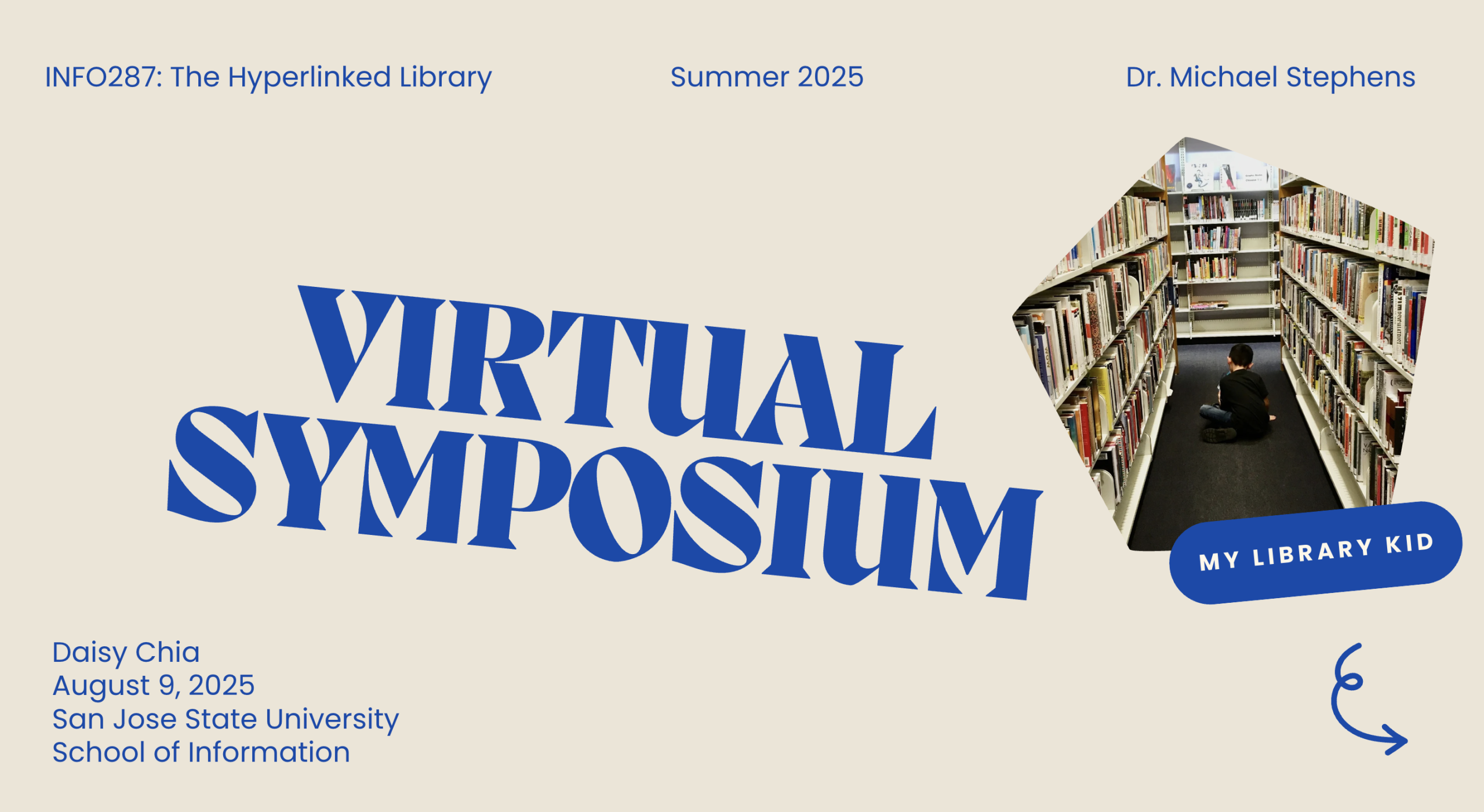
For my virtual symposium, I am presenting my 5 key takeaways from this summer’s class. It’s been a really fun and inspiring class. Looking forward to seeing all of yours.
Video recording is here.
PDF is here.
The idea for this inspiration report was came out of a conversation I had with a library customer. Her name is Enfys which is Welsh for rainbow 🌈. She is losing her vision and her memory isn’t as good as it was, so art and technology programs would not work. Discussing possible ideas with ChatGPT led to memory cafés, a global trend in library services. The report is written for the Toronto Public Library, which currently does not yet host memory cafés.

Here is the PDF of my Inspiration Report.
The library is a space for infinite learning. It is the place for anyone to access books and materials about any subject, for free in most cases. The kind of libraries* we are talking about also allow the public to access technology classes, history classes, art classes, all in person and for free. Virtual programs for all ages are also available. The library also gives library card holders free access to online courses which allow them to earn a certification, add skills to their LinkedIn or resume, learn or practice a new language, and so on. This answers the question:
“In a time when most people turn to Google on their mobile devices for quick answers, what type of learning experiences can the library provide? “ (Stephens, 2014).
The library has transformed, with the advent of the internet, expanding their offerings beyond containers of knowledge towards education and access to technology. But technology is ever changing. This requires libraries to offer their library staff professional learning opportunities to keep up with changing times. In 2006, Helene Blowers created Learning 2.0: 23 Things at the Public Library of Charlotte and Meclenburg County, to help information professionals learn about Web 2.0. It consisted of 23 tasks help them get familiar with things setting up a blog, exploring Flickr, setting up an RSS feed, etc. This program inspired hundreds of other 23 Things! As online students, we are pretty familiar with these although some things have changed in 20 years. It seems that Flickr images and longer form blog posts have been replaced with social media and TikTok videos.
“A computer would deserve to be called intelligent if it could deceive a human into believing that it was human.” –Alan Turing (Curtin University, n.d.)
Artificial intelligence is the biggest new technological change we are facing. As people debate about its advantages as well as very negative effects, technology companies and governments continue to invest heavily in its development while removing any safeguards; while also cutting off funding from libraries, our pillars of democracy. Meanwhile, as librarians, we must learn about AI in order to better serve our public. The Toronto Public Library (2025) is offering a class called What is Artificial Intelligence? A centrally designed slide deck presents provides an overview of the technology for a general adult audience. On further exploration, I found a 23 Things: Thing-AI. As librarians, we must keep learning in order to teach, and this could be a good place to start. Naturally, it was created with the help of ChatGPT (Curtin University, n.d.).
*Side note: I was born in the Philippines and still have a lot of family there. On a visit a few years ago, I walked to the local public library. It is located beside City Hall and is a building with a shell on the roof. Doesn’t it sound like a library from a Haruki Murakami book? Inside, the library is small and the collection was limited. Libraries need funding to maintain their collection and provide the services mentioned above. My dad asked me on my return, “Why did you go?” Recently my dad and my brothers visited me in Toronto. I took them to the Toronto Reference Library and they were surprised to learn that anyone can come here to read, access computers, use the free Wi-Fi, and attend programs for free. They were impressed by the donor list at the entrance of the library. A reminder that libraries cannot thrive without funding.
References
Curtin University. (n.d.). 23 things: Thing-AI. https://23things.library.curtin.edu.au/portfolio/thing-ai/
KlingonSpider. (2012, April 8). Hal9000: “I’m sorry Dave, I’m afraid I can’t do that”[Video]. YouTube. https://www.youtube.com/watch?v=ARJ8cAGm6JE
Lemuel “lem” B. (2019, July). Mandaue City Public Library [Photograph]. https://g.co/kgs/4vkG7Zi
Stephens, M. (2014). Making the case for the library as a space for infinite learning. https://www.dropbox.com/scl/fi/4zt1yliwb2ffzr8euix2p/YLibraryInfiniteLearning.pdf?rlkey=m0v6lkd43ufilkp5aktawhlpr&e=1&dl=0
Toronto Public Library. (2025). What is artificial intelligence? https://www.torontopubliclibrary.ca/detail.jsp?Entt=RDMEVT561987&R=EVT561987
23 things – 10 years later. (2017, March 13). Library Journal. https://www.libraryjournal.com/story/23-things-10-years-later
The Power of Stories

Stories are powerful and integral to the library and human connection. The super power of human beings is that we are able to cooperate in large numbers through the power of stories (Harari, 2022). How can libraries harness the power of stories as a tool for inclusion, connection, and empathy?
“Libraries have should keep stories, share stories and make stories.”
-Erik Boekesteijn (Stephens, 2019).
A few days ago, I was helping a senior at the library. She was looking for social programs she could attend at the library. Her doctor prescribed it. She has been living with vision loss over the last few years and has not been able to enjoy the things she used to. We found some drop in programs for seniors that she can try in the neighbourhood but I also suggested she give audiobooks a try. Although she would still be alone, a good story does offer comfort and can be great company.
It’s no wonder that the ice-breaker group invites the people in this class to share binge-able media! This allowed us to make connections to each other through the shared experience of the story and helped us find new media to consume. For many people, watching media, reading or listening to stories, is part of their self-care.
Collecting Stories
Artist, author, and library staff Christina Wong has always been passionate about collecting stories. In 2015, she collected and exhibited stories connected to Toronto’s Chinatown and the Boys and Girls House Library (which opened in 1922 then later replaced by a new construction in 1995 renamed the Lillian H. Smith branch) for the 20th anniversary of the library. Unfortunately, the link to the online exhibit is no longer active. Her work, along with her collaborators, have been focused on people and their connection to disappearing places through stories. These projects are vital to recording the history of the city as neighbourhoods grapple with rapid changes and disappearing landmarks.

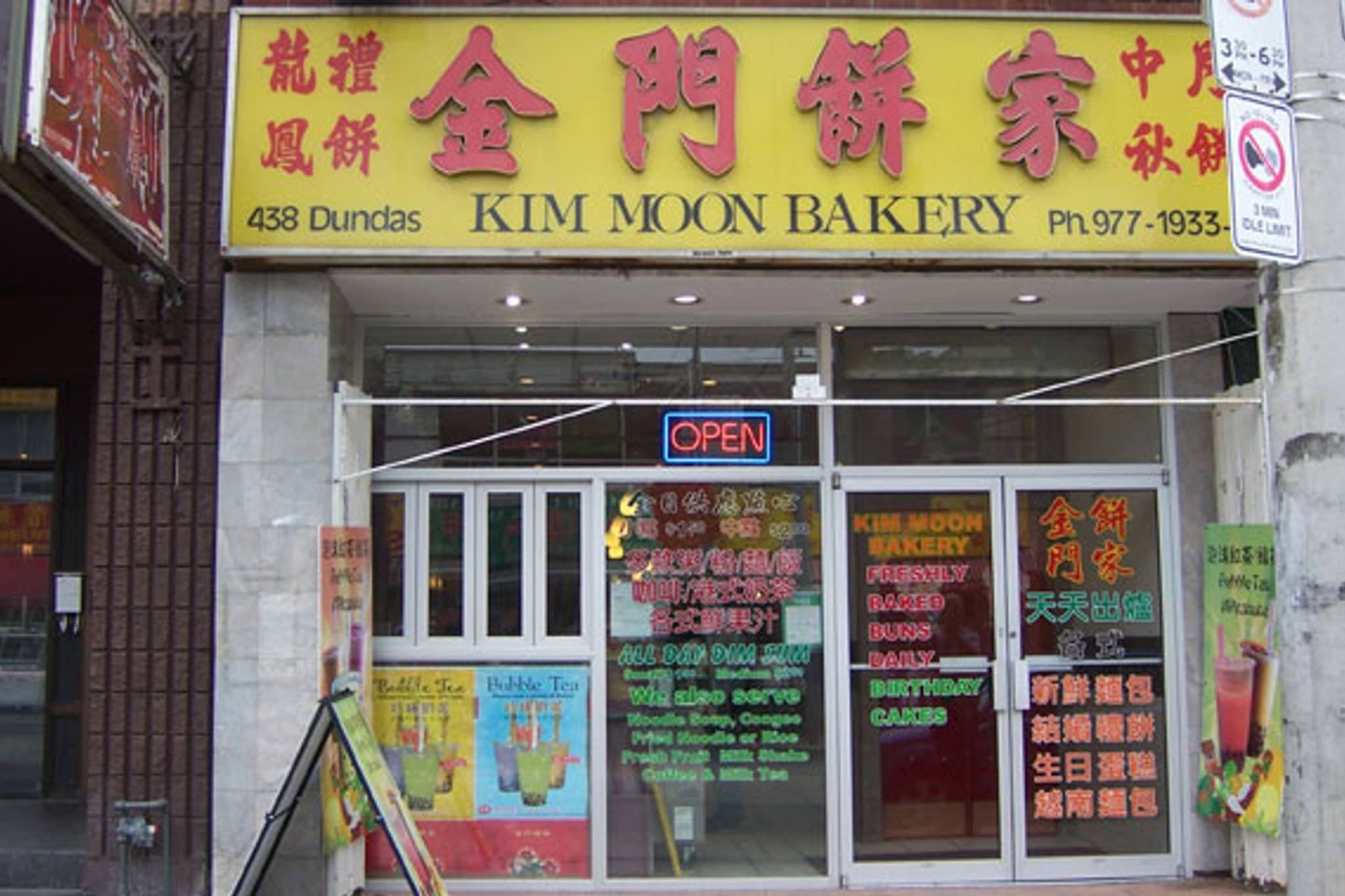
Another place where “Torontonians can contribute their stories, memories, artifacts,” according to Wong (Jennifer, 2015) is the Museum of Toronto. It began as a workshop in 2015 and now has a physical home at 401 Richmond Street West which is free to visit. The current exhibit is called The 52: Stories of women who shaped Toronto. These powerful stories which can be viewed online or in person, as text, video, or performance.
The Human Story and AI
I was reading an article in the NYTimes about a man about to lose his father to illness, persuaded him to work with a company called StoryFile to help preserve his memory. I found this to be revelatory! There are increasing numbers of companies in the field called GriefTech. From apps that help people deal with loss to avatars that will allow you to talk to your loved one through a screen, like you were talking to them on Zoom (Dominus, 2025). I wondered how this kind of technology will change how we preserve stories at the library. What are the costs of preserving someone in the form of an AI chatbot in perpetuity and what format can it be preserved in? Will archives and special collections collect AI simulations of people such as the Japanese American National Museum’s exhibit allowing people to talk to World War II veteran Lawson Sakai (2021)?
References
Blog TO. (2008, July 12). Kim Moon. https://www.blogto.com/restaurants/kimmoon/
Dominus, S. (2025, June 13). Never say goodbye. The New York Times Magazine. https://www.nytimes.com/interactive/2025/06/13/magazine/ai-avatar-life-death.html
Harari, Y. N. (2022). Unstoppable us: How humans took over the world, Vol. 1. Puffin Canada.
Japanese American National Museum. (2021, November 24). The interactive StoryFile of Lawson Iichiro Sakai-exibition preview [Video]. YouTube. https://www.youtube.com/watch?v=JgfSHGJuw2I
Jennifer. (2015, October 16). Q & A with Lillian H. Smith’s digital storyteller Christina Wong. https://torontopubliclibrary.typepad.com/lillian-h-smith/2015/10/qa-with-lillian-h-smiths-digital-storyteller-christina-wong.html
Museum of Toronto. (2025). The 52: Stories of women who transformed Toronto. https://museumoftoronto.com/projects/the-52/
Stephens, M. (2019). Wholehearted librarianship: Finding hope, inspiration, and balance. ALA Editions.
Wong, C. & Innes, D. (2023). Denison Avenue. ECW Press.
Last week, I attended a training session for Mental Health First Aid. It is part of the mandatory training assigned to librarians. It was seven hours of discussions and role playing as we all worked together to apply ALGES to different scenarios. ALGES stands for Approach and assess, Listen, Give reassurance and information, Encourage them to reach out to supports, and lastly Self-care for the first aider (this was a new addition according to our trainers). In many ways, it was similar to First Aid training. You are there as a first responder, you are not there to counsel or diagnose.
At the MHFA training session, one librarian, whom I later learned has a background in social work, asked why our employer was making this mandatory for librarians? Are we being trained to become social workers? She was not happy. I offered that this training was becoming more common in general as my partner had taken it years ago while working as a manager in a warehouse.
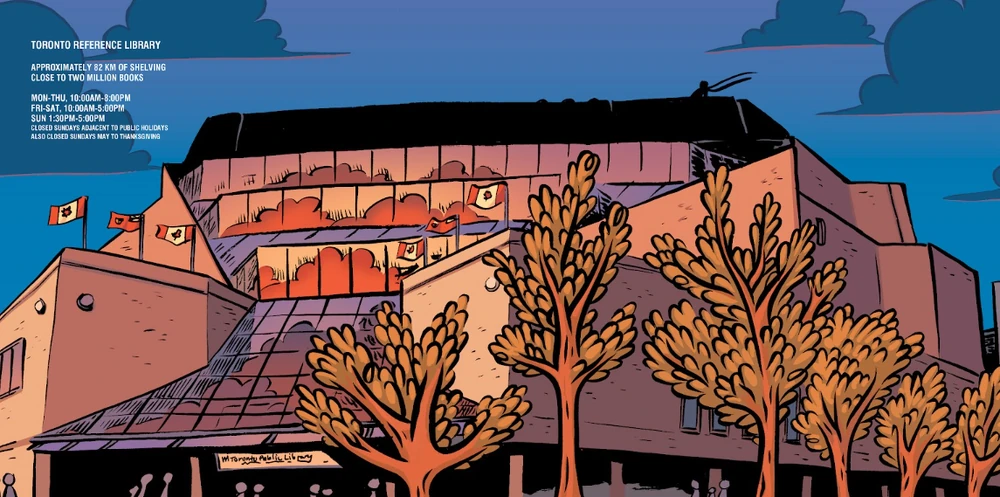
“The Des Moines Public Library is in the process of creating a social worker position at its Central Library to help serve those in the community. The social worker would be able to help library patrons with finding services that can help them and even assist with filling out the paperwork needed (Wright, 2023).”
More and more libraries are hiring social workers to help meet the needs of the community. On my way to work a few days ago, I noticed there was a person sleeping out in the open on each corner of the intersection. Rising homelessness in the city is a major issue. With lack of stable housing come increasing rates of substance use and mental health challenges. If basic needs are not being met, people are coping in other ways. The MHFA training was run by two Library Safety Specialists (LSS), a role created by TPL in 2023 (Toronto Public Library, 2023) which uses a trauma informed approach to de-escalate violent or disruptive incidents (Humber, 2023). They work in high incident branches providing social services to patrons who need it. Additionally, TPL also has a partnership with the Gerstein Crisis Centre which provides Social Services Team (SST) at a few branches around the city. They also run programs to help people and their loved ones find recovery and hope. Recently the program has expanded from one, the Toronto Reference Library, to 12 branches across the city over the last few years.
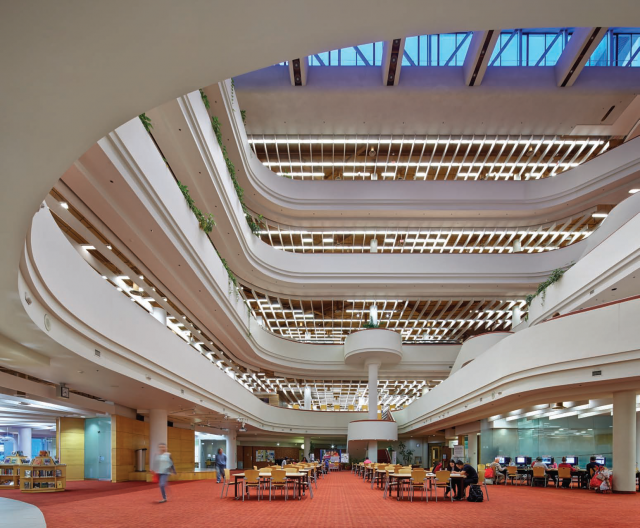
Should library staff be trained in social work? Librarians are often in-charge, especially at smaller branches, are the ones dealing with persons who are agitated or in crisis. Having some training on how to approach, listen, and how to offer help makes sense. Learning what not to say, such as “calm down” or “I understand” from LSS staff is helpful (M. McCausland, personal communication, July 10, 2025). These phrases can be triggering. No, as an employed person with access to housing, do we really understand? Finally, the addition of self care to ALGES is very important. Burnout is real and we need to be able to maintain our empathy and compassion in our work as information professionals.
References
Callan, I. (2019, October 3). Mississauga’s first library-based social worker calls on Brampton to copy the idea. The Pointer. https://thepointer.com/article/2019-10-03/mississauga-s-first-library-based-social-worker-calls-on-brampton-to-copy-the-idea
Gerstein Crisis Centre. (2025, July 4). Gerstein Crisis Centre’s Toronto Public Library project expanded to the following 12 participating library branches… [Post]. Instagram. https://www.instagram.com/p/DLsLeqDggZt/
Humber, T. (2023, September 27). A new chapter: How Niclas Manson is rewriting the script at the Toronto Public Library. OHS Canada. https://www.ohscanada.com/features/a-new-chapter-how-niclas-manson-is-rewriting-the-script-at-toronto-public-library/
KeyKing666. (2024, February 1). Screenshot 2024-02-01 163844 [Image]. https://scottpilgrim.fandom.com/wiki/Toronto_Public_Library
Mental Health First Aid USA. (2021, April 15). ALGEE: How MHFA helps you respond in crisis and non-crisis situations. https://www.mentalhealthfirstaid.org/2021/04/algee-how-mhfa-helps-you-respond-in-crisis-and-non-crisis-situations/
Ontario Association of Architects. (2016, February 19). Toronto Reference Library (1977). https://oaa.on.ca/whats-on/bloaag/bloaag-detail/Toronto-Reference-Library-1977
Opening Minds. (2025). Mental health first aid. https://openingminds.org/training/mhfa/
Toronto Public Library. (2023). Be part of an innovative new team at the library! We’re actively hiring to ensure our public spaces are welcoming…[Post]. LinkedIn. https://www.linkedin.com/posts/torontolibrary_be-part-of-an-innovative-new-team-at-the-activity-7044018629671059456-D1gj#:~:text=2y-,Be%20part%20of%20an%20innovative%20new%20team%20at%20the%20library,apply%20is%20March%2031%2C%202023.
Toronto Public Library. (2025). Social & crisis support services. https://www.torontopubliclibrary.ca/social-crisis-support-services/
Wright, G. (2023, April 10). Des Moines Public Library adding social worker position. https://who13.com/news/metro-news/heres-what-services-the-des-moines-public-librarys-social-worker-position-will-provide/
This idea would not leave me after an experience helping librarians to teach a group of adults how to use the Cricut cutting machine to make greeting cards. The program was presented in a way that invited participants to talk about ageism. It was a challenging yet overall successful program as the participants were eager to do it again! Unfortunately, the librarians were not as thrilled, so no future Cricut programs are in the works. It is too bad because we learned a lot from the experience so the next ones would be so much better!


Link to .pdf.
For the Hyperlinked Environments reflection post, I wanted to look at AI at the library.
Listening to Yuval Noah Harari is always revelatory because he is able to crystallize complex issues into easy to digest, bite-size pieces. He warns us that the AI we are seeing today is extremely primitive. That AI is not a tool we can hold in our hand, but an agent that can make decisions and invent beyond the human imagination (Reid Hoffman, 2025). What will the impact of a highly developed AI on human civilization?
I also looked at how libraries are shouldering the responsibility of educating the public about AI. Seniors called the library to demand AI programs to help them understand what it is. The community has spoken.
We cannot escape the frightening environmental cost of AI. This podcast talks about how the power of AI can help solve the problems we are facing with climate change as well as the high energy and water needs as tech companies continue to invest in and build massive data centres.
Finally, I asked ChatGPT about AI in public libraries. What is the role of the public library in helping their communities adapt to the growing use of AI? It provided a complete answer that included the the libraries role in teaching digital literacy, providing democratic access, promoting ethical stewardship and community dialogue, upskillinng and career training, enhancing reference services, and AI as a tool to break down barriers. It provided the following summary:
“Public libraries are uniquely positioned to democratize access to AI, foster critical thinking about its use, and prepare communities to engage with AI safely and effectively. As trusted, neutral institutions, they are essential in ensuring that the benefits of AI are shared equitably across society.” (OpenAI, 2025)
References
Climate One. (2024, April 19). Climate One rewind: Artificial intelligence, real climate impacts [Audio podcast]. Spotify. https://open.spotify.com/episode/2U5hdk9Go8iIhaV87OGlxA?si=Q3oOyFm9ROaYYdDha6T9jQ
More, S. (2025, April 22). Your politeness to AI is costing millions and harming the environment. Medium. https://shivammore.medium.com/your-politeness-to-ai-costing-millions-and-harming-the-environment-8e5bee3e7874
OpenAI. ChatGPT 4.0 [Large language model]. https://chatgpt.com/c/68631386-3568-8008-b994-9d81cb0f673d
Reid Hoffman. (2025, June 4). Yuval Noah Harari on the dangers of AI [Video]. YouTube. https://www.youtube.com/watch?v=uuBLxWowDqI
Rich Roll Podcast. (2024, October 28). Our AI future is way worse than you think | Yuval Noah Harari [Video]. YouTube. https://www.youtube.com/watch?v=_jl64f-821o
Sidotti, O. & Macclean, C. (2025, June 25). 34% of U.S. adults have used ChatGPT, about double the share in 2023. Pew Research. https://www.pewresearch.org/short-reads/2025/06/25/34-of-us-adults-have-used-chatgpt-about-double-the-share-in-2023/
Toronto Public Library. (2025, January 27). Artificial intelligence policy. https://torontopubliclibrary.typepad.com/board-meetings/2025-01-27/21-artificial-intelligence-policy-combined.pdf
Toronto Public Library. (2025). Learn AI. https://www.torontopubliclibrary.ca/using-the-library/computer-services/learnai/
In this week’s lecture for Hyperlinked Communities, @michael talks about Open+ at the Gwinett County Public Library which allows people to enter the library before or after staffed open hours, increasing access to library services and technology.

In 2019, the Toronto Public Library retrofitted two small branches with Staffless Library technology created by Bibliotheca, the same company which created the technology for self checkouts implemented in 2004 which resulted in the loss of 81 full time positions (Local4948, n.d.). The union fought against move towards Staffless Libraries through an online campaign, lawn signs and these award winning videos created by Head Gear Animation.

Watch the videos here.
From the perspective of library management, and some members of the public, staffless or self-service library hours are a great idea! Just a few weeks ago, I registered a patron for self service access to Todmorden Room, which is located in a community center. It took a few clicks on the computer, a form to fill out and sign which included the rules of conduct, an email and interoffice mail. Now she can visit the library while she is waiting for her children to do their swim lessons. All she has to do is scan her library card and enter her PIN.
I had also heard about an incident where an excluded customer had entered the library during self-service hours, by banging on the door and demanding access to the library. Two customers were already inside and one of them opened the door. The excluded customer yelled, “I need a computer!” and the two customers left. The excluded customer began using the public computers to view inappropriate materials and doing other things that are not appropriate for a public space.
Balancing the risks outlined in the videos (including inappropriate use as outlined above, patron safety, unattended children, etc) and to jobs for library workers with increasing access to library users can be tricky. The library provides a much needed free space for all which includes people who may be experiencing trauma related issues. Does restricted access create issues around service for all which now the public has to navigate?
The self checkout technology implemented in 2004 has made processing books faster as well as improving service to customers. Less line ups and so on. I could not imagine going back to the “old days” although we did experience a version of this during the “down time” after the cyber attack of October 2023.
Is it possible to embrace the convenience and extended service offered by staffless library hours while also maintaining patron safety and keeping library worker jobs? We must try to find a way to balance all of it.
References
Head Gear Animation. (2023, November 29). Head Gear Animation – TPLWU 2 dangers [Video]. YouTube. https://www.youtube.com/watch?v=OCopGuty_nY
Local 4948. (n.d.). Staffless libraries. https://www.local4948.org/issues/staffless-libraries/
Local 4948. (2019, January 20). Thank you for your support, @irismooninthecity ! We have been delivering these lawn signs all over the neighbourhood around Todmorden Room library [Post]. Instagram. https://www.instagram.com/p/Bs4LYZxBdz6/
Stephens, M. (2025). Hyperlinked communities [Video]. Panopto. https://sjsu-ischool.hosted.panopto.com/Panopto/Pages/Viewer.aspx?id=3eacdb23-84fd-49e5-9975-aef3014b3ed2
Stephens, M. (2019). Wholehearted librarianship: Finding hope, inspiration, and balance. ALA Editions.
Toronto Public Library. (2025). Self-service open hours at Swansea and Todmorden Room. https://www.torontopubliclibrary.ca/hours-locations/extended-hours-program/
Telling & Sharing Stories
Why does this theme stand out to you?
Have you ever read Library Mouse by Daniel Kirk (2007)? It is a picture book about mouse named Sam who lives in cozy a hole in the wall behind the Children’s Reference section of the public library. He just loves reading books. One day, he is inspired to write his own. “Write what you know, “ he remembers reading from a book about writing.
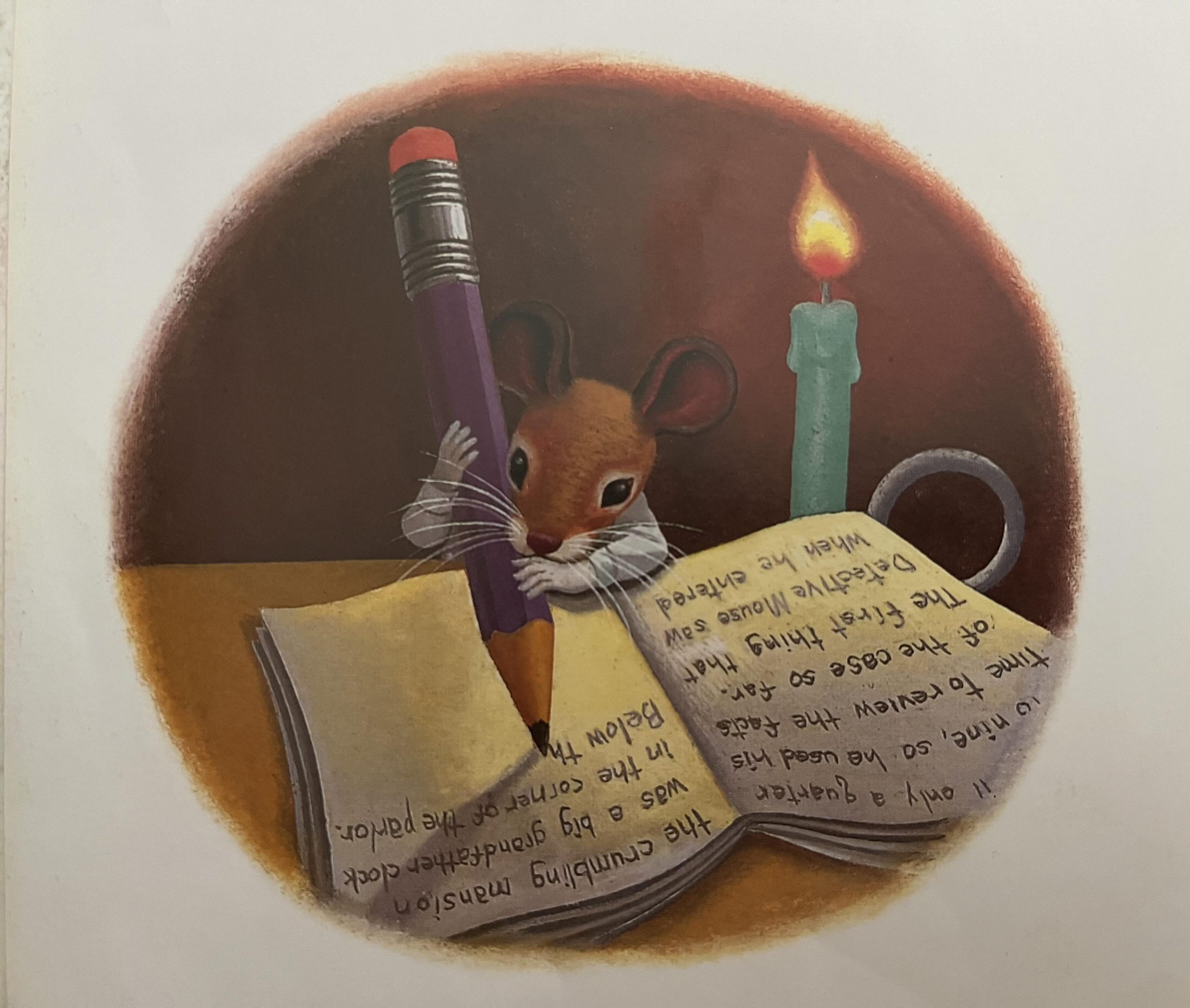
He begins to make his own books, leaving them on the library shelf for humans to find. After self-publishing three books, the librarian leaves him a note on the library bulletin board asking if he would agree to a “Meet the Author” event. He is nervous about this but gets ready for the event by making lots of mouse size books and sharpening some pencils. The following day, everyone is excited to meet the author. A tissue box with a note sits on the table and when the first child looks inside, she sees herself. “Am I an author?” she wonders.
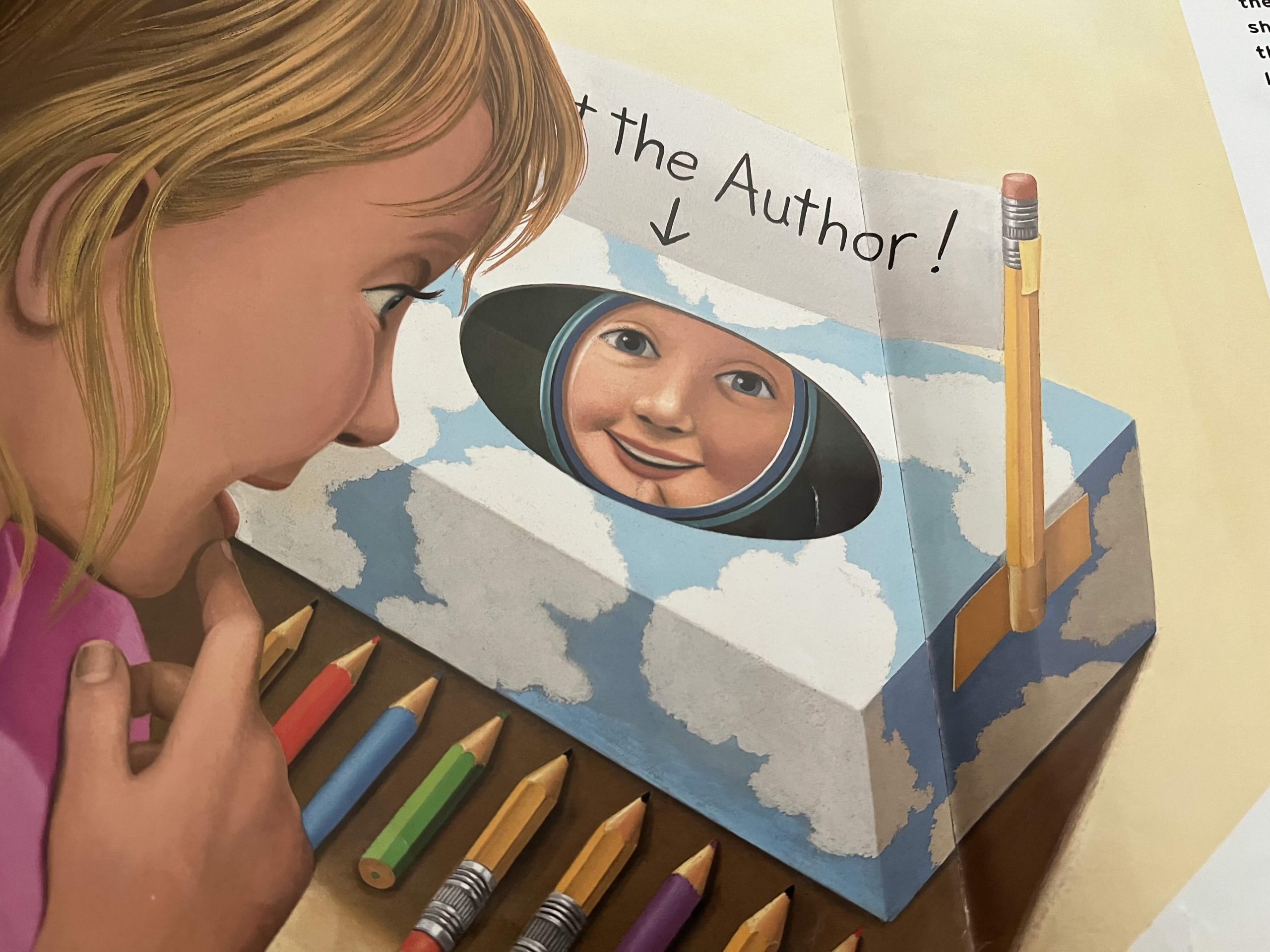
Soon, the children begin to write their own stories and share them with each other at the library. The theme of participatory service is well represented in this story as Sam inspires the children to tell their own stories, while the librarian creates space in the library for sharing them.
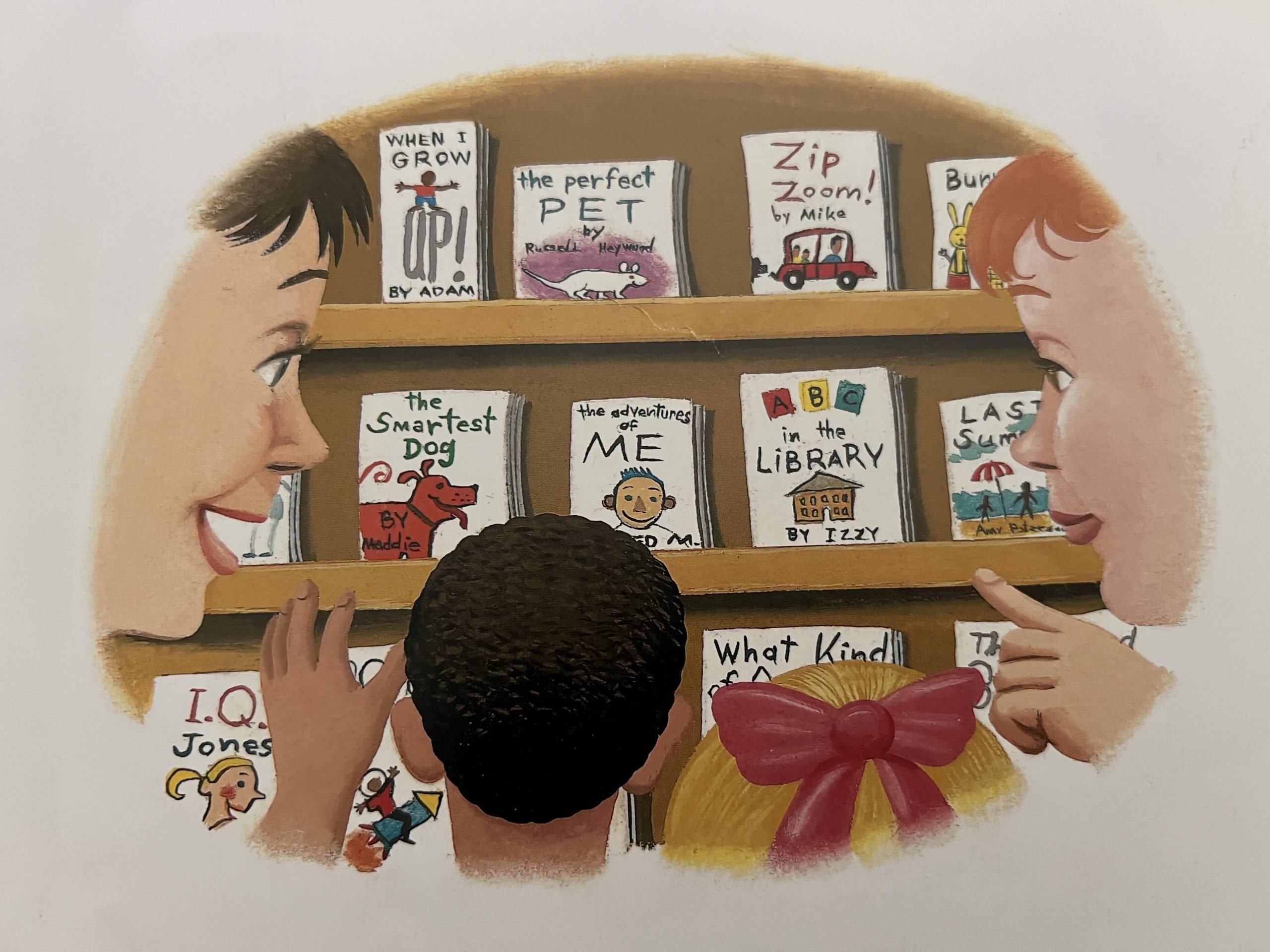
Connecting Past & Future
Can you connect it to your past experiences or future goals?
Since my time in art school, I have always been interested in the idea of viewer as participant. An exploratory project for MAAD (Material Art & Design) process class consisted of a green fabric mound with a zipper, which hoped the viewer would unzip, only to find another zipper, and finally a clay figure. My animation school grad project consisted of a Flash* based interactive website which the viewer could explore through clicks. A cardboard house installation invited the viewer inside to sit at a computer to access the project. Since then, technology has advanced further, allowing anyone with internet access to make interactive games or websites. Scratch, which uses block coding, makes it easy for kids to create animations, games, and interactive stories and the online community invites them to share and remix their creations.
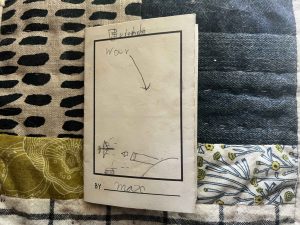 |
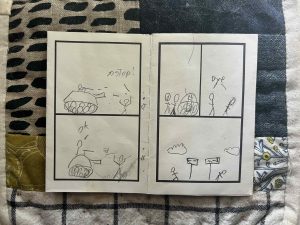 |
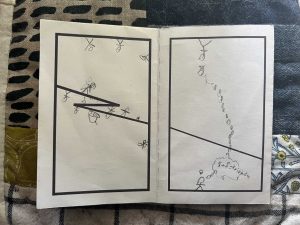 |
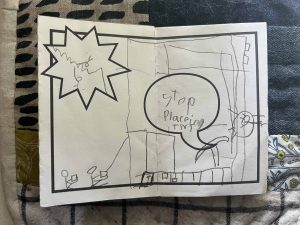 |
| Friends’ War, a mini comic by Max, age 9 (2018). | |||
Inspired by a comic arts exhibit at the Art Gallery of Ontario, I designed and distributed little one page comics for free at craft shows. These booklets were blank inviting young people to tell their own stories. You can download it here. Interactivity was away to draw the viewer into the work. As libraries have evolved beyond being book storehouses, community engagement becomes a key factor in how libraries can better serve their users.
“The evolution of libraries and library service will include a pronounced shift from libraries as book warehouses to libraries as centers for discovery, learning, and creation via any number of platforms.” (Stephens, 2016)
In the chapter, Age of Participation, Stephens (2016) asks, how can we capture the public’s attention despite one-click availability of information? By filling the library user’s needs beyond access to information. An interview with ArtHeart for a school assignment has become the starting point for creating a formal partnership with a community art organization and the public library. Future me dreams of providing consistent art programming, with a focus on wellness through art making, available across all library branches.
Power of Technology

Art galleries and museums are extending their reach beyond the exhibit by using virtual and interactive elements. In 2018, my family and I visited the AGO to see the Anthropocene exhibit. This mind-blowingly beautiful and terrifying exhibit would inspire us to take action against climate change. Big Lonely Doug, a thousand year old Douglas fir tree stands alone on Vancouver Island but augmented reality (AR) was able to bring it to the AGO’s Galleria Italia for visitors to see. Technology as conduit for positive change; extends reach (Stephens, 2016), and breaking logistical barriers.
How might this idea shape your perspective on libraries, learning, and community?
The public library has a mandate to provide the users access to technology through public computers and internet access, take home WI-FI hotspots, STEM programs for children and youth, and Digital Innovation Hubs which provide access to 3D printers, computers that run Adobe Creative Suite, recording studios, and more. But it is not just about having these things available. Librarians and library staff must continuously find creative ways to inspire the public to engage with new technology through impactful programs and services.
Programs like Seniors E-Connect partner teen volunteers with seniors to help them with their technology. This program has been sometimes surprisingly meaningful for librarians, teens, and seniors as it fosters intergenerational bonds and friendships while creating opportunities for teens and seniors to build confidence. An upcoming card making program will introduce the public to the Cricut cutting machine and accompanying Design Space software while discussing age-ism and exploring creative ways to celebrate getting older.
The User is the Sun
Where do you see this theme showing up in practice?
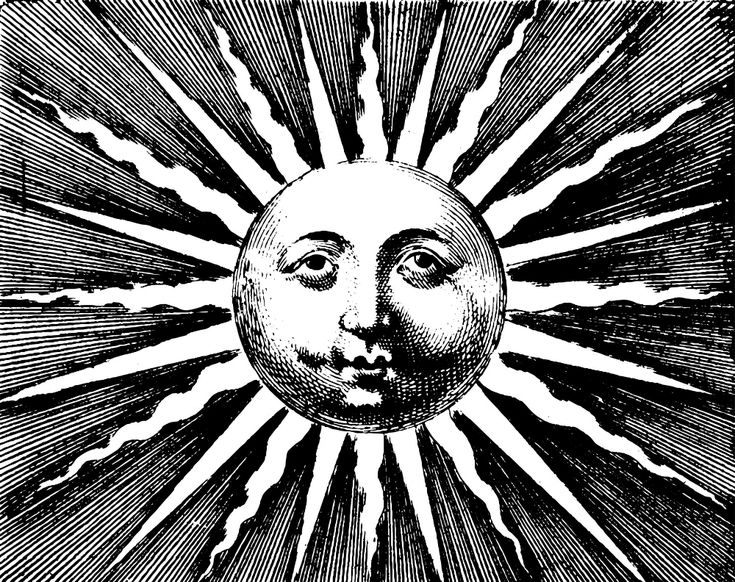
In The User is Not Broken, Scheider (2006) reminds librarians that all technology will become obsolete. Librarians must adapt and change with the times, focusing NOT on format but on service. I can relate to this so much because it has been almost 20 years since my undergrad and trying to dig up my old work can be challenging as the formats are obsolete, and the programs no longer exist. But I am still here and I still want to create conditions for community participation.
A public suggestion board, like the one at Traverse Area District Library mentioned in this week’s lecture at (Stephens, 2025.), allows for transparency and interaction between the patrons and library staff. Patrons have opinions and maybe the staff don’t always want to hear them. Our library does have a whole department for dealing with user questions called Answerline. They can redirect the user as needed.

Just this week, a library patron informed me that the spines of the books on the bottom shelf of the Adult Fiction section are completely unreadable except for the call number because of how they are oriented. This is great for pages and staff but difficult for the public.
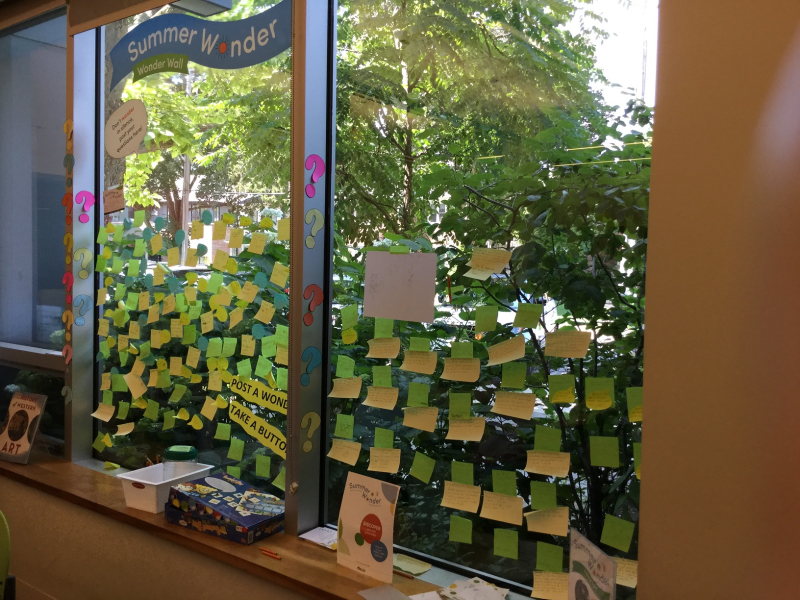
Every summer, the library creates a Summer Wonder wall that invites library patrons to write their questions on. Staff reply with a call number or a small paragraph with the answer.
The Library as the Community’s Space
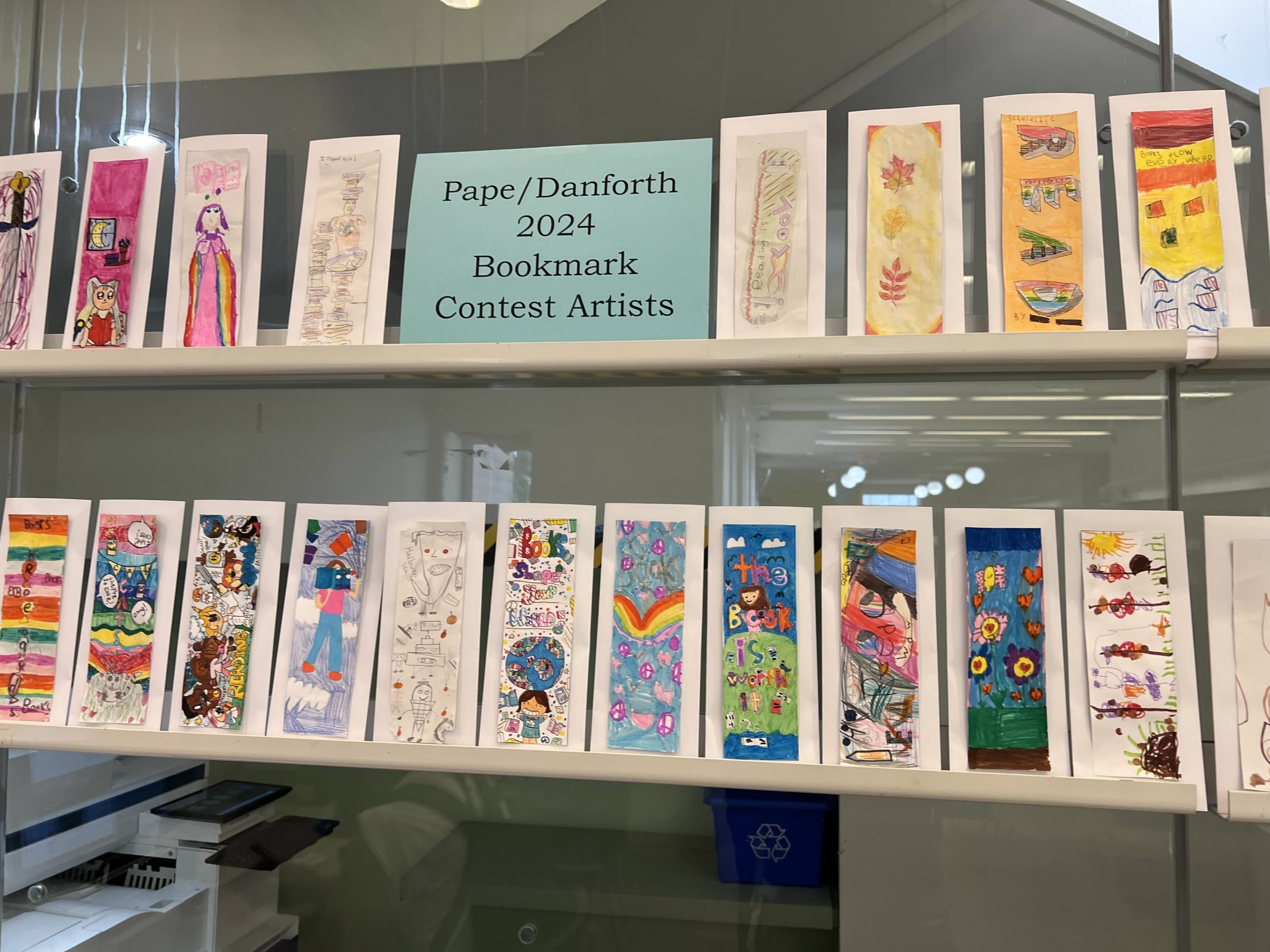
In my work as a public service assistant, I talk to people every day. These last few months at my current branch, I have been talking to art-loving seniors. One needs help registering for all the art programs at branches across the city. She then returns to colour copy her work. One was looking for seniors programs close to home as travelling can be a challenge. She was looking for a place to connect while being creative. One gentleman was talking about his love of painting and was so excited to hear that the library offers exhibition space. He had an art exhibition many years ago but it had been expensive. The application process for this year is now closed however I hope he applies in the future. I can already see that technology may be a barrier for him. These chats did make me wonder about creating a library art club for seniors or school age children (or both together) that meet on a weekly or monthly basis. At the end of the session, the work could be exhibited at the branch. A project like this would create a strong sense of belonging for library users. As Serhan Ada (Stephens, 2016) puts it:
“Participation occurs when someone welcomed as a guest feels as though they have become a host.”
References
Art Gallery of Ontario. (2018, October 1). The story of Big Lonely Doug. https://ago.ca/agoinsider/story-big-lonely-doug
ArtHeart. (n.d.). Celebrating 34 years of community engaged arts! 1991-2025. https://www.artheart.ca/
Kirk, D. (2007). Library mouse. Abrams Books for Young Readers.
Laurie. (2019, August 15). Summer Wonder: Creativity challenges and fascinating facts. https://torontopubliclibrary.typepad.com/kids-books/2019/08/creativity_challenges_fascinating_facts.html
Public Domain Pictures. (n.d.). Vintage sun. https://www.publicdomainpictures.net/en/view-image.php?image=80896&picture=
Schneider, K. G. (2006, June 3). The user is not broken: A meme masquerading as a manifesto. Free Range Librarian. https://freerangelibrarian.com/2006/06/03/the-user-is-not-broken-a-meme-masquerading-as-a-manifesto/
Stephens, M. (2016). The heart of librarianship: Attentive, positive and purposeful change. ALA Editions.
Stephens, M. (2025). Hyperlinked library participatory service & transparency [Video]. Panopto. https://sjsu-ischool.hosted.panopto.com/Panopto/Pages/Viewer.aspx?id=2a19a4b6-e945-4d2e-abf1-aef3014172a
Toronto Public Library. (2025). Customer feedback standards and practices. https://www.torontopubliclibrary.ca/about-the-library/customer-care/
My name is Daisy. I am in my final semesters of the Library Science program here at SJSU with plans to graduate this fall. I wanted to take the Hyperlinked Library after taking INFO200 where Michael was the main lecturer for that course. Your passion for libraries was apparent and I have heard good things about this course. I am currently working in a public library as a public service assistant. I love the library. My passion is helping people find what they need. Before this, I was a stay at home mom, caring for my two children. We were avid library users; visiting the library almost daily and sometimes twice in one day. I live in Toronto with my husband, two teenagers, an eight year old beagle lab mix named Lucy, and a ten month old munchkin kitten named Theodore. I have recently become the lady who walks her dog with the cat in a backpack.